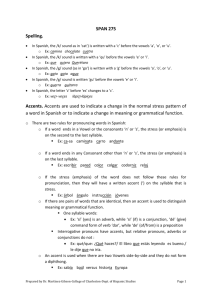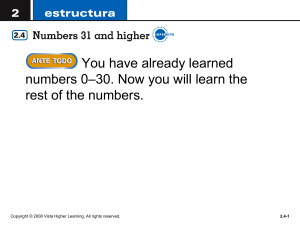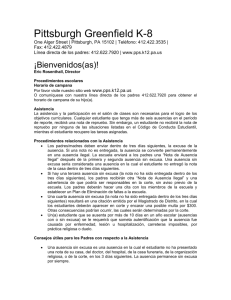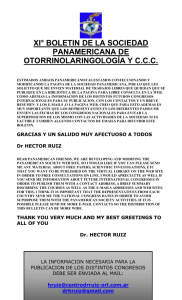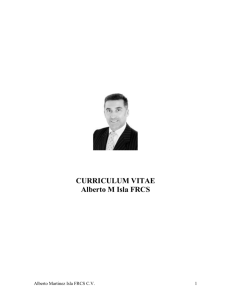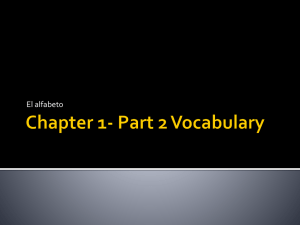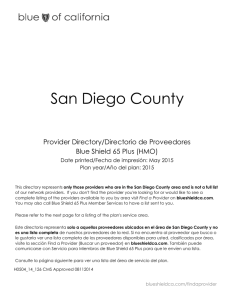050106b
advertisement
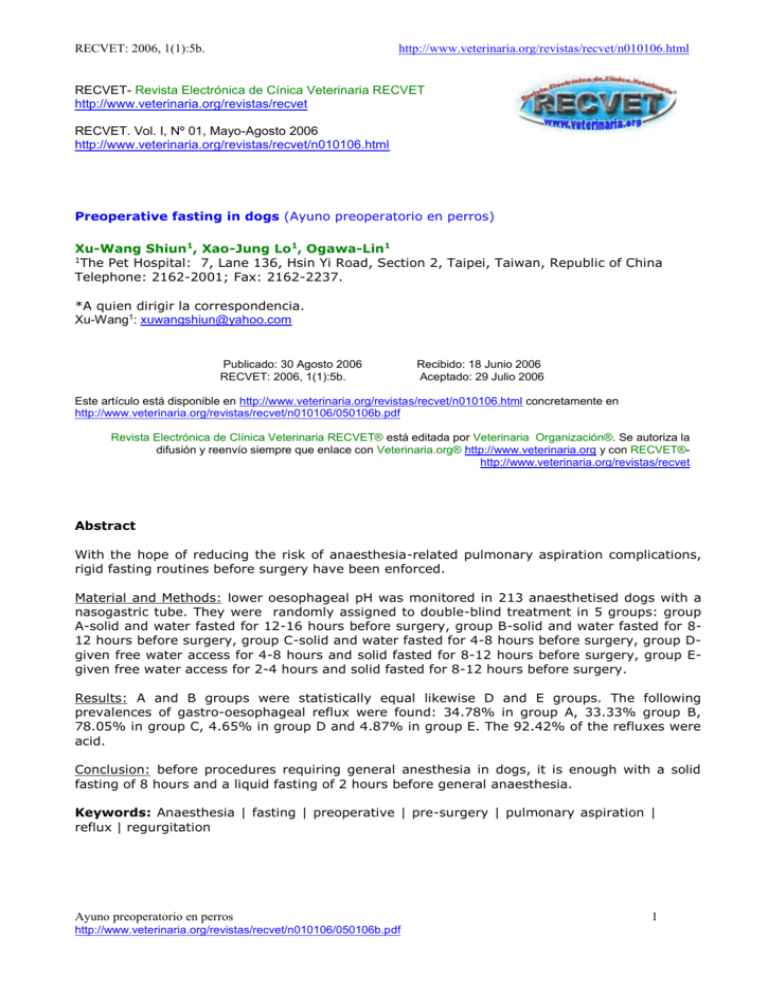
RECVET: 2006, 1(1):5b. http://www.veterinaria.org/revistas/recvet/n010106.html RECVET- Revista Electrónica de Cínica Veterinaria RECVET http://www.veterinaria.org/revistas/recvet RECVET. Vol. I, Nº 01, Mayo-Agosto 2006 http://www.veterinaria.org/revistas/recvet/n010106.html Preoperative fasting in dogs (Ayuno preoperatorio en perros) Xu-Wang Shiun1, Xao-Jung Lo1, Ogawa-Lin1 1 The Pet Hospital: 7, Lane 136, Hsin Yi Road, Section 2, Taipei, Taiwan, Republic of China Telephone: 2162-2001; Fax: 2162-2237. *A quien dirigir la correspondencia. Xu-Wang1: xuwangshiun@yahoo.com Publicado: 30 Agosto 2006 RECVET: 2006, 1(1):5b. Recibido: 18 Junio 2006 Aceptado: 29 Julio 2006 Este artículo está disponible en http://www.veterinaria.org/revistas/recvet/n010106.html concretamente en http://www.veterinaria.org/revistas/recvet/n010106/050106b.pdf Revista Electrónica de Clínica Veterinaria RECVET® está editada por Veterinaria Organización®. Se autoriza la difusión y reenvío siempre que enlace con Veterinaria.org® http://www.veterinaria.org y con RECVET®http://www.veterinaria.org/revistas/recvet Abstract With the hope of reducing the risk of anaesthesia-related pulmonary aspiration complications, rigid fasting routines before surgery have been enforced. Material and Methods: lower oesophageal pH was monitored in 213 anaesthetised dogs with a nasogastric tube. They were randomly assigned to double-blind treatment in 5 groups: group A-solid and water fasted for 12-16 hours before surgery, group B-solid and water fasted for 812 hours before surgery, group C-solid and water fasted for 4-8 hours before surgery, group Dgiven free water access for 4-8 hours and solid fasted for 8-12 hours before surgery, group Egiven free water access for 2-4 hours and solid fasted for 8-12 hours before surgery. Results: A and B groups were statistically equal likewise D and E groups. The following prevalences of gastro-oesophageal reflux were found: 34.78% in group A, 33.33% group B, 78.05% in group C, 4.65% in group D and 4.87% in group E. The 92.42% of the refluxes were acid. Conclusion: before procedures requiring general anesthesia in dogs, it is enough with a solid fasting of 8 hours and a liquid fasting of 2 hours before general anaesthesia. Keywords: Anaesthesia | fasting | preoperative | pre-surgery | pulmonary aspiration | reflux | regurgitation Ayuno preoperatorio en perros http://www.veterinaria.org/revistas/recvet/n010106/050106b.pdf 1 RECVET: 2006, 1(1):5b. http://www.veterinaria.org/revistas/recvet/n010106.html Resumen Con la esperanza de reducir el riesgo de problemas de aspiración pulmonar se utilizan rígidos protocolos de ayuno preoperatorio. Material y métodos: con una sonda nasogástrica se monitorizó el Ph de la parte distal del esófago en 213 perros anestesiados. Los perros fueron asignados aleatoriamente en un estudio a doble ciego en 5 grupos: el grupo-A con ayuno sólido y líquido de 12-16 horas antes de la cirugía, el grupo-B con ayuno sólido y líquido de 8-12 horas antes de la cirugía, el grupo-C con ayuno sólido y líquido de 4-8 horas antes de la cirugía, el grupo-D con ayuno sólido de 8-12 horas y líquido de 4-8 horas antes de la cirugía, y el grupo-E con ayuno sólido de 8-12 horas y líquido de 2-4 horas antes de la cirugía. Resultados: el grupo A era estadísticamente igual al B y el D al E. Se encontraron las siguientes prevalencias de reflujo gastroesofágico: 34.78% en el grupo A, 33.33% en el grupo B, 78.05% en el grupo C, 4.65% en el grupo D y 4.78% en el grupo E. El 92.42% de los reflujos se caracterizaron por ser de naturaleza ácida. Conclusión: antes de realizar procedimientos que requieran anestesia general en el perro, es suficiente con un ayuno a sólidos de 8 horas y un ayuno a líquidos de 2 horas, siendo recomendable la ingestión de líquidos hasta 2 horas antes de la anestesia general pues reduce el reflujo. Palabras clave: Anestesia | aspiración pulmonar | ayuno | preoperatorio | prequirúrgico | reflujo | regurgitación Introduction Anaesthesia-related pulmonary aspiration leading to respiratory failure (Aspiration Pneumonitis; Mendelson’s syndrome) has been described in both elective and emergency surgical patients (Edwards eta al., 1956; Bannister and Sattilaro, 1962; Olsson et al., 1986; Mellin-Olsen et al., 1996; Warner, et al., 1993; Søreide et al., 1996; Kluger and Short, 1999). With the hope of reducing the risk of this complication, rigid fasting routines before surgery have been enforced (McIntyre, 1998). However, the scientific basis for these rigid fasting routines in elective patients has been challenged and found to be nonexistent (Maltby et al., 1986; Phylips et al., 1993; Søreide et al., 1995). Based on this new information, several national anaesthesia societies now have accepted more liberal fasting rules for clear fluids (water, clear juices, coffee, tea) (Strunin et al., 1993; Erickson and Sandin, 1996; Søreide et al., 1997; American Task Force, 1999; Ljungquist and Søreide, 2003; Spies et al., 2003). Intake of solids in the morning of elective surgery is still not recommended. Numerous controlled studies and meta-analysis have concluded that in otherwise healthy adults scheduled for elective surgery, oral intake of water and other clear fluids (tea, coffee, soda water, apple and pulp-free orange juice) up to 2 h before induction of anaesthesia does not increase gastric fluid volume or acidity (Maltby et al., 1986; Phylips et al., 1993; Søreide et al., 1995; American Task Force, 1999; Brady et al., 2003). The studies were performed in both male and females adults (the study was in adults), and in different countries (Brady et al., 2003). Based on the new data, most national anaesthesiology societies now recommend until 2-h fasting for clear fluids (water, tea, coffee, pulp-free fruit juices) in elective patients, both adults and children and including pregnant women not in labour (Strunin et al., 1993; Erickson and Sandin, 1996; Søreide et al., 1997; American Task Force, 1999; Ljungquist and Søreide, 2003; Spies et al., 2003). Importantly, this does not apply to milk, any other fat-containing fluids, or solids. No complications associated with the new and more liberal fasting guidelines have been reported (Brady et al., 2003; Fasting et al., 1998). To provide sufficient safety Ayuno preoperatorio en perros http://www.veterinaria.org/revistas/recvet/n010106/050106b.pdf 2 RECVET: 2006, 1(1):5b. http://www.veterinaria.org/revistas/recvet/n010106.html margins, the fasting period after intake of solids should not be less than 6 h (Søreide et al., 1996; Brock-Utne, 1996). In dogs most of the reflux episodes occurred shortly after the induction of anaesthesia and prolonging preoperative fasting is associated with an increased incidence of reflux and increased gastric acidity (Galatos and Raptopoulos, 1995). Material and Methods Lower oesophageal pH was monitored in 213 (116 females and 97 males) anaesthetised dogs with a nasogastric tube. Dogs had a weight between 7 and 65 kgs and were randomly assigned to double-blind treatment in 5 groups: group A-solid and water fasted for 12-16 hours before surgery, group B-solid and water fasted for 8-12 hours before surgery, group C-solid and water fasted for 4-8 hours before surgery, group D-given free water access for 4-8 hours and solid fasted for 8-12 hours before surgery, group E-given free water access for 2-4 hours and solid fasted for 8-12 hours before surgery. We considered a positive gastro-oesophageal reflux (GOR) when stomach contents were brought back up into the oesophagus. All the surgeries were done between 8:00am-06:00 pm. For anaesthesia induction we use diazepan (IV: 0.3mg/kg) + propophol (IV:4-8mg/Kg)+ inhalatory halothane (2-4%) and N2O (70%). For anaesthesia maintenance we use inhalatory halothane (0.8-1.2%) and N2O (50%). The distribution was normal and groups were analysed and compared using contingency table Chi-square analysis with a 95% confidence interval. Results Chi-square analysis showed not significant differences *(P>0.05) between A-B groups (A and B were statistically equal), and D-E groups (D and E were statistically equal). Nevertheless, there were high significant differences *(P<0.0001) between groups A-B, C and D-E. The following prevalences of gastro-oesophageal reflux were found (Table 1): 34.78% in group A, 33.33% group B, 78.05% in group C, 4.65% in group D and 4.87% in group E. In the positive cases (n=66) the reflux was: acid (pH < 6.5) in 92.42% (n=61) of the cases (n=66), alkaline (pH> 7.5) in 6.06% (n=4) of the cases and neutral (6.5< pH < 7.5) in 1.52% (n=1) of the cases. Table 1. Chi-square analysis to “Positive Reflux” factor Group Total dogs (n) Positive Reflux % Positive Reflux A (12-16h solid and H2O fasted) 46 16 34.78% B (8-12h solid and H2O fasted) 42 14 33.33% C (4-8h solid and H2O fasted) 41 32 78.05% D (8-12h solid+ 4-8h H2O fasted) 43 2 4.65% E (8-12h solid+ 2-4h H2O fasted 41 2 4.87% Ayuno preoperatorio en perros http://www.veterinaria.org/revistas/recvet/n010106/050106b.pdf 3 RECVET: 2006, 1(1):5b. http://www.veterinaria.org/revistas/recvet/n010106.html Disscusion Preoperative fasting is associated with an increased incidence of reflux and increased gastric acidity in dogs (Galatos and Raptopoulos, 1995). Numerous controlled studies and metaanalysis have concluded that in healthy adults scheduled for elective surgery, oral intake of water and other clear fluids (tea, coffee, soda water, apple and pulp-free orange juice) up to 2 h (Maltby et al., 1986; Phylips et al., 1993; Søreide et al., 1995; American Task Force, 1999; Brady et al., 2003) and oral intake of solids up to 6 hours (Søreide et al., 1996; Brock-Utne, 1996) before induction of anaesthesia does not increase gastric fluid volume or acidity. We agree with these statements because of the fact that: 1.- The shorter fasting for solid (group C: 4-8 h) has the highest prevalence of reflux but a fasting for solids longer than 8 hours (groups A and B) has a lower prevalence of reflux. 2.- Fasting for fluids (water) until 2-4 hours (group E) before the surgery has the same prevalence of reflux than a fasting for fluids until 4-8 hours (group D). In both groups (DE) reflux was statistically much lower than in A-B groups (fasting for fluids higher than 8 hours). We complete the aforementioned statements saying that our results show that fasting for fluids shouldn’t be longer than 8 hours and fasting for solids shouldn’t be shorter than 8 hours. Drinking fluids 2-8 hours before surgery and fasting for solids longer than 8 hours are the best option to reduce the reflux. Conclusion Before procedures requiring general anesthesia in dogs, it is enough with a solid fasting of 8 hours and a liquid fasting of 2 hours before surgery. Drinking fluids until 2 hours before the general anaesthesia reduce the reflux. Bibliografía 1. Edwards G., Morton H.J.V., Pask E.A., Wylie W.D., 1956. Deaths associated with anaesthesia. A report on 1000 cases. Anaesthesia. 11, 194-220. 2. Bannister W.K., Sattilaro A.J., 1962. Vomiting and aspiration during anesthesia. Anesthesiology. 23, 251-64. 3. Olsson G.L., Hallen B., Hambraeus-Jonzon K., 1986. Aspiration during anaesthesia: computer-aided study of 185,358 anaesthetics. Acta. Anaesthesiol. Scand. 30, 84-92. 4. Mellin-Olsen J., Fasting S., Gisvold S.E., 1996. Routine preoperative gastric emptying is seldom indicated. A study of 85,594 anaesthetics with special focus on aspiration pneumonia. Acta. Anaesthesiol. Scand. 40, 1184-8. 5. Warner M.A., Warner M.E., Weber J.G., 1993. Clinical significance of pulmonary aspiration in the perioperative period. Anesthesiology. 78, 56-62. 6. Søreide E., Bjørnestad E., Steen P.A., 1996. An audit of Aspiration Pneumonitis in gynaecological and obstetric patients. Acta. Anaesthesiol. Scand. 40, 14-9. 7. Kluger M.T., Short T.G., 1999. Aspiration during anaesthesia: a review of 133 cases from the Australian Anaesthesia Incident Monitoring Study (AIMS). Anaesthesia. 54, 1926. 8. McIntyre J.W., 1998. Evolution of 20th century attitudes to prophylaxis of pulmonary aspiration during anaesthesia. Can. J. Anaesth. 45, 1024-30. 9. Maltby J.R, Sutherland A.D, Sale J.P, Shaffer E.A., 1986 Preoperative oral fluids: is a five-hour fast justified prior to elective surgery? Anesth. Analg. 65, 1112-6. 10. Philips S., Hutchinson S., Davidson T., 1993 Preoperative drinking does not affect gastric contents. Br. J. Anaesth. 70, 6-9. Ayuno preoperatorio en perros http://www.veterinaria.org/revistas/recvet/n010106/050106b.pdf 4 RECVET: 2006, 1(1):5b. http://www.veterinaria.org/revistas/recvet/n010106.html 11. Søreide E., Strømskag K.E., Steen P.A., 1995. Statistical aspects in studies of preoperative fluid intake and gastric content. Acta. Anaesthesiol. Scand. 39, 738-43. 12. Strunin L., 1993 How long should patients fast before surgery? Time for new guidelines (Editorial). Br. J. Anaesth. 70, 1-3. 13. Erikson L.I., Sandin R., 1996. Fasting guidelines in different countries. Acta Anaesthesiol. Scand. 40, 971-4. 14. Søreide E., Fasting S., Ræder J., 1997. New preoperative fasting guidelines. Acta. Anaesthesiol. Scand. 41, 799. 15. American Task Force on Preoperative Fasting, 1999. Practice guidelines for preoperative fasting and the use of pharmacological agents to reduce the risk of pulmonary aspiration: application to healthy patients undergoing elective procedures. A report by the American Task Force on Preoperative Fasting. Anesthesiology. 90, 896-905. 16. Ljungqvist O., Søreide E., 2003. Preoperative fasting. Br. J. Surg. 90, 400-6. 17. Spies C.D, Breuer J.P, Wichmann M., Adolph M., Senkal M., Kampa U., et al., 2003. Preoperative fasting. An update. Anaesthesist. 52, 1039-45. 18. Brady M., Kinn S., Stuart P., 2003. Preoperative fasting for adults to prevent perioperative complications. In. Cochrane Database Syst Rev 2003;(4). Hoboken: John Wiley & Sons. 19. Fasting S., Søreide E., Ræder J., 1998. Changing preoperative fasting policies. Does national consensus help? Acta. Anaesthesiol. Scand, 42, 1188-92. 20. Søreide E., Hausken T., Søreide J.A., Steen P.A., 1996. Gastric emptying of a light hospital breakfast. A study using ultrasonography. Acta. Anaesthesiol. Scand. 40, 54953. 21. Brock-Utne J.G., 1996. Clear fluids, not breakfast, before surgery. Acta. Anaesthesiol. Scand. 40, 507-8. 22. Galatos A.D., Raptopoulos D., 1995. Gastro-oesophageal reflux during anaesthesia in the dog: the effect of preoperative fasting and premedication. Vet. Rec. 137, 479-83. RECVET® Revista Electrónica de Clínica Veterinaria está editada por Veterinaria. Organización®. Es una revista científica, arbitrada, online, trimestral y con acceso completo a los artículos íntegros. Publica preferentemente trabajos de investigación originales referentes a la Medicina y Cirugía Veterinaria desde el aspecto Clínico en cualquier especie animal. Se puede acceder vía web a través del portal Veterinaria.org® http://www.veterinaria.org o desde RECVET® http://www.veterinaria.org/revistas/recvet Dispones de la posibilidad de recibir el Sumario de cada número por correo electrónico solicitándolo a recvet@veterinaria.org Si deseas postular tu artículo para ser publicado en RECVET® contacta con recvet@veterinaria.org después de leer las Normas de Publicación en http://www.veterinaria.org/revistas/recvet/normas.html Se autoriza la difusión y reenvío de esta publicación electrónica siempre que se cite la fuente, enlace con Veterinaria.org®. http://www.veterinaria.org y RECVET® http://www.veterinaria.org/revistas/recvet Veterinaria Organización S.L.® (Copyright) 1996-2006 Email: info@veterinaria.org Ayuno preoperatorio en perros http://www.veterinaria.org/revistas/recvet/n010106/050106b.pdf 5
